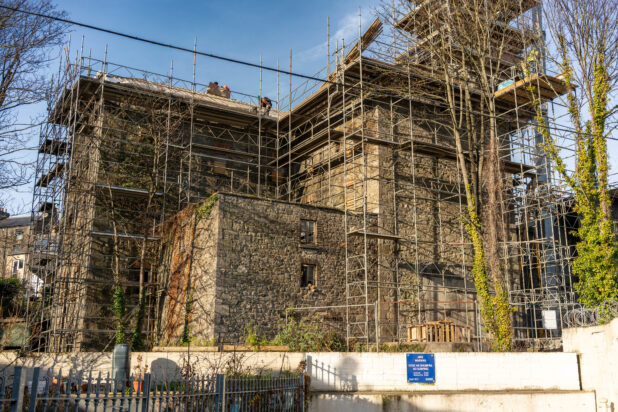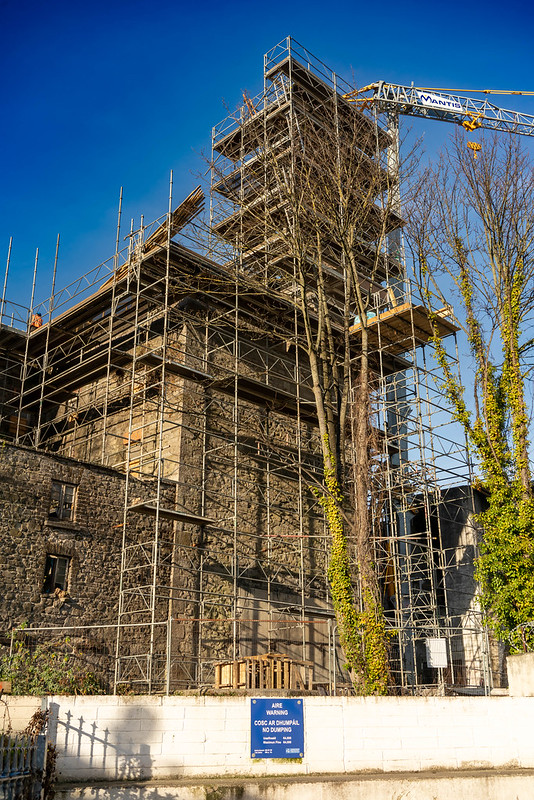Kilmainham Mill Restoration Project Continues Apace – Aidan Crowley provides us with an update on the work at the mill
Dublin City Council (DCC) commenced the first phase of major work, last summer, to conserve and restore local landmark, Kilmainham Mill, thought to be the last surviving mill building in the city. The structure, which was originally built around 1800, also appears to be the last remaining and largely unaltered early nineteenth century flour mill in Dublin and is likely to be the last remaining textile mill in Ireland.
The historic site, at Rowserstown Lane, off Kilmainham Lane, which was originally a flour mill, grinding corn, later became a textile mill, making finished fabric for international fashion designers and soft furnishings. It was purchased in 2018 by DCC, following a long campaign by local residents to save it from demolition and unwanted development.
The overall plan for Kilmainham Mill is to create a new cultural hub and destination within the Kilmainham/Inchicore catchment area. The mill complex, when fully restored, could act as a community hub, simultaneously telling the story of the building’s industrial heritage, while providing a significant visitor/tourism experience, interactive industrial opportunities for employment and craft production.
The Kilmainham Mill complex is strategically located at the heart of Kilmainham, over-looking the River Camac. It consists of early nineteenth to mid-twentieth century buildings, together with an in-filled millrace and is listed as a protected structure on the Record of Protected Structures (RPS) and is also a recorded monument. It ceased all industrial use as a mill in 2000 and has remained unoccupied since then, falling into a major state of dereliction and disrepair.
The principle aim of the restoration project is to ensure the conservation and restoration of the building and its historically significant features, while at the same time, developing a state-of-the-art industrial amenity. This would have the effect of creating a cultural hub in the Kilmainham/Inchicore area of the city, which also includes other local sites of historical interest, such as Kilmainham Gaol, the Royal Hospital, the War Memorial Gardens and Richmond Barracks.
The current enabling works, which are being conducted on behalf of DCC, by Howley Hayes Cooney Architects, in conjunction with structural engineers, an archaeologist, ecologists and industrial heritage specialists, has focused on making the site safe and secure, ahead of a longer-term restoration plan. Operations, to date, have included the propping of floors and roofs, the removal of asbestos from the site, the removal of Japanese Knotweed and the protection of the old industrial machinery.
Other essential works, included in the restoration project are the demolition of some late twentieth century out-buildings of no historic significance, the removal of asbestos from pipes, roof tiles, floor tiles and the clearance of debris, including pigeon guano etc.
Meanwhile, the ongoing works have revealed many fascinating details of the working life of the mill, in tandem with many salvaged items of important industrial heritage.
One such find is the ornate letterhead of Charles H. Bates & Co. Bates, who was a native of Huddersfield, England, was a cloth shrinker and finisher by profession. He bought over the defunct flour mill in 1904 and established a textile finishing works. This company continued to operate until 1973 when it was replaced by Weavers Shed Ltd.
The letterhead shows how the mill was powered, before the advent of electricity. It was originally driven by the waterwheel which was fed from the River Camac. The chimney, illustrated on the letterhead, signifies the steam engine which was installed by an earlier owner, William Brophy, as a back-up when he took over the then-flour mill from Patrick Dowling in the 1860’s.
Other historical artefacts which have been salvaged, during the initial phase of the restoration, include various types of machinery, cloth cuttings and industrial paper records.
Going forward, this first phase of the conservation, will involve the continuation of extensive roof repairs and water-proofing to all areas of the mill complex, along with the meticulous recording and protection of all artefacts of industrial heritage. All windows in the building will be secured and screened and safe walkways will be installed. This will have the effect of making the site safe and secure for the next phase of the restoration work.
DCC has also commissioned an updated conservation plan for the mill complex, now that all areas within the building have become accessible. The process of developing a long-term re-use and restoration strategy for the building, as well as engaging with wider stakeholders in the local community, will begin later this year. The total cost of the restoration project is estimated at Euros 1.7 million, according to DCC.
Project manager, DCC’s Darragh Cunningham says that, when completed, the restoration will be “a game changer in terms of visitor attractions. From a tourist and economic point of view, this will really compliment Kilmainham Gaol, IMMA and the Memorial Gardens, opening up another tourist attraction in the area”.
dublincity.ie/residential/parks/new-parks-and-projects/kilmainham-mill











Save the mill my great grandfather worked there.